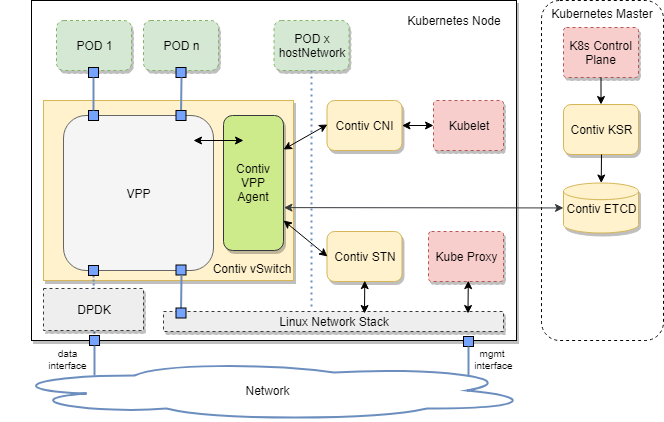Contiv/VPP Kubernetes Network Plugin
Overview
Kubernetes is a container orchestration system that efficiently manages Docker containers. The Docker containers and container platforms provide many advantages over traditional virtualization. Container isolation is done on the kernel level, which eliminates the need for a guest virtual operating system, and therefore makes containers much more efficient, faster, and lightweight. The containers in Contiv/VPP are referred to as PODs.
Contiv/VPP is a Kubernetes network plugin that uses FD.io
VPP to provide network connectivity between PODs in
a k8s cluster (k8s is an abbreviated reference for kubernetes). It
deploys itself as a set of system PODs in the kube-system namespace,
some of them (contiv-ksr, contiv-etcd) on the master node, and
some of them (contiv-cni, contiv-vswitch, contiv-stn) on
each node in the cluster.
Contiv/VPP is fully integrated with k8s via its components, and it automatically reprograms itself upon each change in the cluster via k8s API.
The main component of the VPP
solution, which runs within the contiv-vswitch POD on each node in
the cluster. The VPP solution also provides POD-to-POD connectivity
across the nodes in the cluster, as well as host-to-POD and
outside-to-POD connectivity. This solution also leverages VPP’s fast
data processing that runs completely in userspace, and uses
DPDK for fast access to the network IO layer.
Kubernetes services and policies are also a part of the VPP configuration, which means they are fully supported on VPP, without the need of forwarding packets into the Linux network stack (Kube Proxy), which makes them very effective and scalable.
Architecture
Contiv/VPP consists of several components, each of them packed and shipped as a Docker container. Two of them deploy on Kubernetes master node only:
The rest of them deploy on all nodes within the k8s cluster (including the master node):
The following section briefly describes the individual Contiv components, which are displayed as orange boxes on the picture below:

Contiv/VPP Architecture
Contiv KSR
Contiv KSR (Kubernetes State Reflector) is an agent that subscribes to k8s control plane, watches k8s resources and propagates all relevant cluster-related information into the Contiv ETCD data store. Other Contiv components do not access the k8s API directly, they subscribe to Contiv ETCD instead. For more information on KSR, read the KSR Readme.
Contiv ETCD
Contiv/VPP uses its own instance of the ETCD database for storage of k8s cluster-related data reflected by KSR, which are then accessed by Contiv vSwitch Agents running on individual nodes. Apart from the data reflected by KSR, ETCD also stores persisted VPP configuration of individual vswitches (mainly used to restore the operation after restarts), as well as some more internal metadata.
Contiv vSwitch
vSwitch is the main networking component that provides the connectivity to PODs. It deploys on each node in the cluster, and consists of two main components packed into a single Docker container: VPP and Contiv VPP Agent.
VPP is the data plane software that provides the connectivity between PODs, host Linux network stack, and data-plane NIC interface controlled by VPP:
PODs are connected to VPP using TAP interfaces wired between VPP, and each POD network namespace.
host network stack is connected to VPP using another TAP interface connected to the main (default) network namespace.
data-plane NIC is controlled directly by VPP using DPDK. Note, this means that this interface is not visible to the host Linux network stack, and the node either needs another management interface for k8s control plane communication, or [STN (Steal The NIC)](SINGLE_NIC_SETUP.html) deployment must be applied.
Contiv VPP Agent is the control plane part of the vSwitch container. It is responsible for configuring the VPP according to the information gained from ETCD, and requests from Contiv STN. It is based on the Ligato VPP Agent code with extensions that are related to k8s.
For communication with VPP, it uses VPP binary API messages sent via shared memory using GoVPP. For connection with Contiv STN, the agent acts as a GRPC server serving CNI requests forwarded from the Contiv CNI.
Contiv CNI
Contiv CNI (Container Network Interface) is a simple binary that implements the Container Network Interface API and is being executed by Kubelet upon POD creation and deletion. The CNI binary just packs the request into a GRPC request and forwards it to the Contiv VPP Agent running on the same node, which then processes it (wires/unwires the container) and replies with a response, which is then forwarded back to Kubelet.
Contiv STN Daemon
This section discusses how the Contiv [STN (Steal The NIC)](SINGLE_NIC_SETUP.html) daemon operation works. As already mentioned, the default setup of Contiv/VPP requires two network interfaces per node: one controlled by VPP for data facing PODs, and one controlled by the host network stack for k8s control plane communication. In case that your k8s nodes do not provide two network interfaces, Contiv/VPP can work in the single NIC setup, when the interface will be “stolen” from the host network stack just before starting the VPP and configured with the same IP address on VPP, as well as on the host-VPP interconnect TAP interface, as it had in the host before it. For more information on STN setup, read the [Single NIC Setup README](./SINGLE_NIC_SETUP.html)